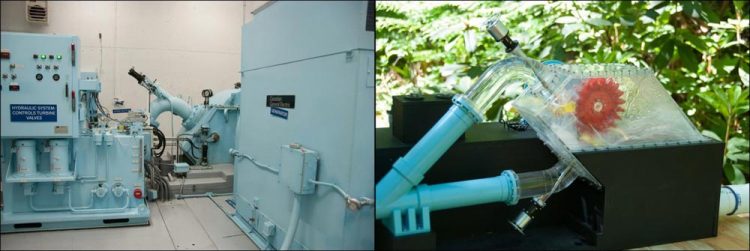New technology could improve use of small-scale hydropower in developing nations

This image shows both a model and a working small scale hydropower system in the central Oregon Cascade Range. Photo courtesy of Oregon State University
Engineers at Oregon State University have created a new computer modeling package that people anywhere in the world could use to assess the potential of a stream for small-scale, “run of river” hydropower, an option to produce electricity that's of special importance in the developing world.
The system is easy to use; does not require data that is often unavailable in foreign countries or remote locations; and can consider hydropower potential not only now, but in the future as projected changes in climate and stream runoff occur.
OSU experts say that people, agencies or communities interested in the potential for small-scale hydropower development can much more easily and accurately assess whether it would meet their current and future energy needs.
Findings on the new assessment tool have been published in Renewable Energy, in work supported by the National Science Foundation.
“These types of run-of-river hydropower developments have a special value in some remote, mountainous regions where electricity is often scarce or unavailable,” said Kendra Sharp, the Richard and Gretchen Evans Professor in Humanitarian Engineering in the OSU College of Engineering.
“There are parts of northern Pakistan, for instance, where about half of rural homes don't have access to electricity, and systems such as this are one of the few affordable ways to produce it. The strength of this system is that it will be simple for people to use, and it's pretty accurate even though it can work with limited data on the ground.”
The new technology was field-tested at a 5-megawatt small-scale hydropower facility built in the early 1980s on Falls Creek in the central Oregon Cascade Range. At that site, it projected that future climate changes will shift its optimal electricity production from spring to winter and that annual hydropower potential will slightly decrease from the conditions that prevailed from 1980-2010.
Small-scale hydropower, researchers say, continues to be popular because it can be developed with fairly basic and cost-competitive technology, and does not require large dams or reservoirs to function. Although all forms of power have some environmental effects, this approach has less impact on fisheries or stream ecosystems than major hydroelectric dams. Hydroelectric power is also renewable and does not contribute to greenhouse gas emissions.
One of the most basic approaches is diverting part of a stream into a holding basin, which contains a self-cleaning screen that prevents larger debris, insects, fish and objects from entering the system. The diverted water is then channeled to and fed through a turbine at a lower elevation before returning the water to the stream.
The technology is influenced by the seasonal variability of stream flow, the “head height,” or distance the water is able to drop, and other factors. Proper regulations to maintain minimum needed stream flow can help mitigate environmental impacts.
Most previous tools used to assess specific sites for their small-scale hydropower potential have not been able to consider the impacts of future changes in weather and climate, OSU researchers said, and are far too dependent on data that is often unavailable in developing nations.
This free, open source software program was developed by Thomas Mosier, who at the time was a graduate student at OSU, in collaboration with Sharp and David Hill, an OSU associate professor of coastal and ocean engineering. It is now available to anyone on request by contacting Kendra.sharp@oregonstate.edu.
This system will allow engineers and policy makers to make better decisions about hydropower development and investment, both in the United States and around the world, OSU researchers said in the study.
Media Contact
All latest news from the category: Information Technology
Here you can find a summary of innovations in the fields of information and data processing and up-to-date developments on IT equipment and hardware.
This area covers topics such as IT services, IT architectures, IT management and telecommunications.
Newest articles

First-of-its-kind study uses remote sensing to monitor plastic debris in rivers and lakes
Remote sensing creates a cost-effective solution to monitoring plastic pollution. A first-of-its-kind study from researchers at the University of Minnesota Twin Cities shows how remote sensing can help monitor and…

Laser-based artificial neuron mimics nerve cell functions at lightning speed
With a processing speed a billion times faster than nature, chip-based laser neuron could help advance AI tasks such as pattern recognition and sequence prediction. Researchers have developed a laser-based…

Optimising the processing of plastic waste
Just one look in the yellow bin reveals a colourful jumble of different types of plastic. However, the purer and more uniform plastic waste is, the easier it is to…



